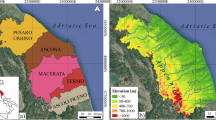Abstract
The results of a comparative analysis of the underlying surface brightness temperature obtained from the SMOS satellite and calculated with the use of ground-based measurements of moisture and the laboratory measurements of dielectric characteristics of samples of saline soils and saline water from test sites of the Kulunda Steppe are presented. The values of the underlying surface brightness temperatures calculated with the use of ground investigations and the laboratory studies correlate satisfactorily with the values of brightness temperatures measured from the SMOS satellite. The deviations can be caused by the seasonal drying of highly mineralized shallow lakes, which results in a significant change in the areas occupied by lakes and the appearance (instead of a water surface) of wetlands with a high content of mineral salts, whose radio emission characteristics differ from the characteristics of the water surface and the soil cover.




Similar content being viewed by others
REFERENCES
Bell, D., Menges, C., Ahmad, W., and Zyl, J.J., The application of dielectric retrieval algorithms for mapping soil salinity in a tropical coastal environment using airborne polarimetric SAR, Remote Sens. Environ., 2001, vol. 75, no. 3, pp. 375–384.
Bouaziz, M., Matschullat, J., and Gloaguen, R., Improved remote sensing detection of soil salinity from a semi-arid climate in northeast Brazil, C. R. Geosci., 2011, vol. 343, nos. 11–12, pp. 795–803.
Ding, J-L., Wu, M-C., and Tiyip, T., Study on soil salinization information in arid region using remote sensing technique, Agric. Sci. China, 2011, vol. 10, no. 3, pp. 404–411.
Font, J., Lagerloef, G., Kerr, Y., Skou, N., and Berger, M., Sea surface salinity mapping with SMOS space mission, Elsevier Oceanogr. Ser., 2003, vol. 69, pp. 186–189.
Gutierrez, A. and Castro, R., SMOS L1 Processor L1c Data Processing Model/SO-DS-DME-L1PP-0009, no. 2.7, 31 May2010. http://www.smos.com.pt/downloads/release/documents/SO-DS-DME-L1PP-0009-DPM-L1c.pdf.
Gutierrez, M. and Johnson, E., Temporal variations of natural soil salinity in an arid environment using satellite images, J. South Am. Earth Sci., 2010, vol. 30, no. 1, pp. 46–57.
Karpachevskii, L.O., Salt-Affected Soils in the Soil Cover of Russia, Eurasian Soil Sci., 2007, vol. 40, no. 7, pp. 802–803.
Khan, N.M., Rastoskuev, V.V., Sato, Y., and Shiozawa, S., Assessment of hydrosaline land degradation by using a simple approach of remote sensing indicators, Agric. Water Manage., 2005, vol. 77, nos. 1–3, pp. 96–109.
Komarov, S.A., Mironov, V.L., and Romanov, A.N., Aerokosmicheskoe zondirovanie gidrologicheskogo sostoyaniya pochv radiofizicheskimi metodami (Aerospace Sounding of the Hydrological State of Soils by Radiophysical Methods), Barnaul: AltGU, 1997.
Melendez-Pastor, I., Navarro-Pedreño, J., Koch, M., and Gómez, I., Applying imaging spectroscopy techniques to map saline soils with ASTER images, Geoderma, 2010, vol. 158, nos. 1–2, pp. 55–65.
Metternicht, G.I. and Zinck, J., A remote sensing of soil salinity: Potentials and constraints, Remote Sens. Environ., 2003, vol. 85, no. 1, pp. 1–20.
Mialon, A., How to build your DGG, 2011. http://www. cesbio.ups-tlse.fr/SMOS-blog/?tag=isea-grid.
Mulder, V.L., Bruin, S., Schaepman, M.E., and Mayr, T.R., The use of remote sensing in soil and terrain mapping—A review, Geoderma, 2011, vol. 162, nos. 1–2, pp. 1–19.
Panciera, R., Walker, J.P., Kalma, J., and Kim, E., A proposed extension to the soil moisture and ocean salinity level 2 algorithm for mixed forest and moderate vegetation pixels, Remote Sens. Environ., 2011, vol. 115, no. 12, pp. 3343–3354.
Pankova, E.I. and Vorob’eva, L.A., Zasolennye pochvy Rossii (Saline Soils in Russia), Moscow: Akademkniga, 2006.
Pinori, S., Crapolicchio, R., and Mecklenburg, S., Preparing the ESA-SMOS mission—Overview of the user data products and data distribution strategy, 10th Special Meeting on Microwave Radiometry and Remote Sensing of the Environment, Florence, Italy, 11–14 March2008. http://microrad2008.cetem.org/public/posters/ poster-Pinori-et-al.pdf.
Reutov, E.A. and Shutko, A.M., Theoretical studies of the microwave radiation of uniformly moistened saline soils, Issled. Zemli Kosmosa, 1990a, no. 3, pp. 73–81.
Reutov, E.A. and Shutko, A.M., Experimental studies of the microwave radiation of saline soils, Issled. Zemli Kosmosa, 1990b, no. 4, pp. 78–84.
Romanov, A.N., Dielektricheskie i radioizluchatel’nye svoistva zasolennykh pochv v mikrovolnovom diapazone (Dielectric and Radio Emission Properties of Saline Soils in the Microwave Range), Barnaul: AltGU, 2002.
Romanov, A.N., Remote assessment of the degree of soil degradation from radiation properties of soils, Eurasian Soil Sci., 2009, vol. 42, no. 3, pp. 326–333.
Sadovnichii, V.A., Kosmicheskoe zemlevedenie (Space Agriculture), Moscow: MGU, 1992.
Sahr, K., White, D., and Kimerling, A.J., Geodesic discrete global grid systems, Cartogr. Geogr. Inf. Sci., 2003, vol. 30, no. 2, pp. 121–134.
Wan, Z., MODIS Land Surface Temperature Algorithm Theoretical Background Document (LST ATBD), Washington, D.C.: National Aeronautics and Space Administration, U.S. Department of Commerce, 1999. https:// modis.gsfc.nasa.gov/data/atbd/atbd_mod11.pdf.
ACKNOWLEDGMENTS
We are grateful to our international colleagues Susanne Mecklenburg, Luca Festa (ESTRIN/ESA), and Arnaud Mialon (SECBIO) for helpful advice on processing the SMOS data.
Funding
The experimental studies were supported by the Russian Foundation for Basic Research _p_Sibir’, grant no. 13-05-98041 “Study of Seasonal Variations of Microwave Emission of Saline and Bitter Lakes in Southern West Siberia,” and Integration Interdisciplinary Project of Siberian Branch, RAS no. 69 “Integrated Studies of Climatic, Hydrological, and Ecosystem Processes on the Territory of West Siberian Swamps.” The SMOS images were provided under the ESA project no. 4747 “Remote Mapping of Siberian Saline Soils.”
Author information
Authors and Affiliations
Corresponding author
Additional information
Translated by L. Mukhortova
Rights and permissions
About this article
Cite this article
Romanov, A.N., Khvostov, I.V. On the Validation of Satellite Microwave Remote Sensing Data under Soil Salinity Conditions. Izv. Atmos. Ocean. Phys. 55, 1033–1040 (2019). https://doi.org/10.1134/S0001433819090445
Received:
Published:
Issue Date:
DOI: https://doi.org/10.1134/S0001433819090445




